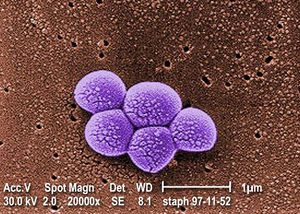Pseudomonas aeruginosa (Project in Progress): Difference between revisions
(Work in Progress) |
No edit summary |
||
| Line 27: | Line 27: | ||
Include some current research, with at least one figure showing data.<br> | Include some current research, with at least one figure showing data.<br> | ||
<br> | <br> | ||
<i>Pseudomonas aeruginosa</i> is a gram-negative species of bacilli shaped bacteria. The genome consists of a rather large, single circular chromosome spanning 5.5-7 Mbp, with an additional variety of plasmids at its disposal (Lee et al., 2006; Klockgether et al., 2011). Both the genome and the plasmids found in this species exist for the benefit of its survival and proliferation in its given environment. With a reputation for being one of the most adaptable and resilient types of bacteria, P. aeruginosa possesses a genome that tends to be larger than most other species of bacteria that have been sequenced so far, and for a good reason: P. aeruginosa is an opportunistic species, and fairs well in a multitude of different environments such as soil, water, plants, animals as well as being one of the top 3 causes of opportunistic human infection (Römling, 1997; Stover et al., 2000). | |||
Every point of information REQUIRES CITATION using the citation tool shown above. | Every point of information REQUIRES CITATION using the citation tool shown above. | ||
Latest revision as of 15:51, 23 February 2024
Section

By [Author Name]
At right is a sample image insertion. It works for any image uploaded anywhere to MicrobeWiki.
The insertion code consists of:
Double brackets: [[
Filename: PHIL_1181_lores.jpg
Thumbnail status: |thumb|
Pixel size: |300px|
Placement on page: |right|
Legend/credit: Magnified 20,000X, this colorized scanning electron micrograph (SEM) depicts a grouping of methicillin resistant Staphylococcus aureus (MRSA) bacteria. Photo credit: CDC. Every image requires a link to the source.
Closed double brackets: ]]
Other examples:
Bold
Italic
Subscript: H2O
Superscript: Fe3+
Sample citations: [1]
[2]
A citation code consists of a hyperlinked reference within "ref" begin and end codes.
To repeat the citation for other statements, the reference needs to have a names: "<ref name=aa>"
The repeated citation works like this, with a forward slash.[1]
Section 1
Include some current research, with at least one figure showing data.
Pseudomonas aeruginosa is a gram-negative species of bacilli shaped bacteria. The genome consists of a rather large, single circular chromosome spanning 5.5-7 Mbp, with an additional variety of plasmids at its disposal (Lee et al., 2006; Klockgether et al., 2011). Both the genome and the plasmids found in this species exist for the benefit of its survival and proliferation in its given environment. With a reputation for being one of the most adaptable and resilient types of bacteria, P. aeruginosa possesses a genome that tends to be larger than most other species of bacteria that have been sequenced so far, and for a good reason: P. aeruginosa is an opportunistic species, and fairs well in a multitude of different environments such as soil, water, plants, animals as well as being one of the top 3 causes of opportunistic human infection (Römling, 1997; Stover et al., 2000).
Every point of information REQUIRES CITATION using the citation tool shown above.
Section 2
Include some current research, with at least one figure showing data.
Section 3
Include some current research, with at least one figure showing data.
Section 4
Conclusion
References
Authored for BIOL 238 Microbiology, taught by Joan Slonczewski,at Kenyon College,2024
